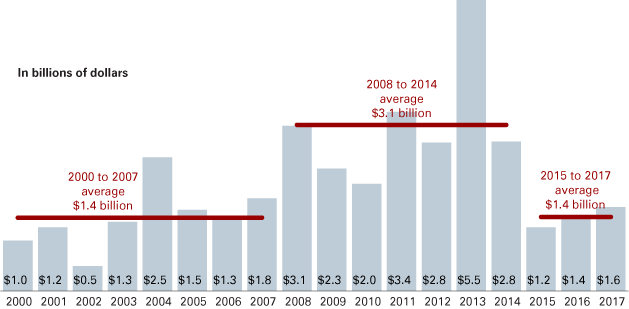Indiana’s farm economy: Some improvements in 2019

Agricultural Economist, Department of Agricultural Economics, Purdue University
After three years of depressed income, the Indiana farm economy will show signs of moderate recovery in 2019. The recovery will be led by record corn and soybean yields in the fall of 2018 with a large portion of the crop sold in 2019. Government trade assistance due to the damaging tariffs will be important in supporting farm incomes as well.
How low has farm income been? From 2008 to 2014, Indiana farm income averaged more than $3.1 billion annually. However, for the last three years from 2015 to 2017, that figure dropped to an average of $1.4 billion annually (see Figure 1). That is more than a 50 percent drop in average annual income. Recent years have been characterized by negative cash flows and declining equity for many farm families. Farmers have responded by pushing costs downward and striving to increase efficiencies. Many have had to increase their debt loads with their lenders.
Figure 1: Indiana net farm income (actual dollars)

Source: U.S. Department of Agriculture
Cropping agriculture
Income prospects for crop farms should improve in 2019 when much of the 2018 fall crops will be sold. The U.S. Department of Agriculture (USDA) expects the state to have record corn yields of 194 bushels per acre. This is about 13 percent above the normal yield for 2018. Corn prices are also expected to be somewhat higher as well. The U.S. average corn price for the 2017 crop was $3.36 per bushel and is expected to rise to $3.60 a bushel for the 2018 crop. Revenues per acre will be about $95 higher than for the 2017 crop. Costs of production were $10-$15 per acre higher, so net returns are up about $80-$85.
Soybean prices have been severely harmed by Chinese tariffs, but U.S. government trade assistance will help compensate for these large tariff losses. Indiana yields are forecast at a record 60 bushels per acre. This is 14 percent above normal yields for 2018. U.S. prices averaged $9.33 per bushel for the 2017 crop, but with the Chinese tariff in place are anticipated to fall to an $8.60 average for the current 2018 crop.
Due to the price damage from the tariffs, the Trump administration provided financial assistance to a number of farm commodities. Soybeans were judged by USDA analysts to have suffered the most damage due to the huge magnitude of Chinese purchases. Farmers are to receive $1.65 per bushel on the first one-half of their 2018 soybean production. This is equivalent to $0.825 on all of their production. When the $0.825 per bushel of trade assistance is added to a market price of $8.60, this provides a total revenue of $9.425. This is higher than the $9.33 per bushel for the 2017 crop.
With the record-high yields and trade assistance, soybean revenues per acre in Indiana will be up $60 per acre from the 2017 crop. Costs were about $10 per acre higher, so net returns will be up about $50 per acre.
While farmers have been trying to push their costs lower, it appears that will be a struggle in 2019 as some input prices are expected to rise. Fall fertilizer prices have risen, diesel fuel and propane prices are higher, labor wages are higher, and interest costs are all expected to be up in 2019.
Farmland values and cash rents
Land values in Indiana fell from 2014 to 2017 as incomes were depressed. Average-quality land fell 13 percent over this period. In 2018, farmland stabilized and had a slight uptick, rising 2 percent. Average-quality Indiana farmland had a value of $7,072 per acre in June 2018, according to the Purdue Farmland Values Survey.
Cash rents have followed a similar pattern, falling 12 percent and then rising 2 percent in 2018. Average-quality Indiana farmland produces 173 bushels per acre over time and had an average cash rent of $210 per acre.
Animal agriculture
The animal sector of Indiana agriculture has a mixed outlook for 2019 depending on the species. The pork sector has been expanding production since 2014 and prices have been moving lower. Many pork producers had negative margins in 2018 due to low hog prices, partially from tariffs on U.S. pork exports to China and Mexico. If these trade disputes can be resolved in 2019, then prices may be high enough to cover all costs despite 3 percent more production. Beef cattle producers should see modestly higher cattle prices in 2019. Demand for beef remains strong even in the face of 3 percent more output in 2019.
The dairy sector had a difficult year in 2018 with U.S. all milk prices at $16.25 per hundred pounds. Many family dairies suggest they need near $18 to breakeven. Prices are expected to improve in 2019 to $17.15. This would still be below full breakeven, yet a positive improvement over 2018.
The poultry sector should have favorable incomes in 2019. Turkey prices are expected to rise. Chicken prices may fall modestly, while egg prices are expected to be lower but still at profitable levels. Continued low feed prices will also be favorable to returns.
Summary
Indiana agriculture has had depressed incomes since 2015. Some recovery is anticipated for 2019. That will be led by record-high corn and soybean yields for the 2018 crops with much of that sold in 2019. Trade assistance from the federal government to help compensate for losses from Chinese tariffs will also be important.
After several years of driving costs lower, it now appears production costs will rise in 2019. This means that margins will remain tight and some farm families will continue to see negative cash flows. Farmland values that dropped after the 2014 peaks seem to have leveled off for now. More stable land values will help stabilize the overall farm family equity.



